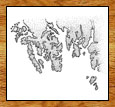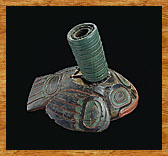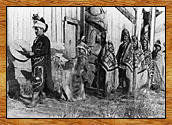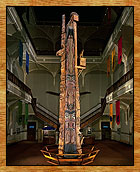 
|
Klinkwan

Klinkwan is the Haida version of a Tlingit name meaning Shellfish Town. The village stretched around several bays and contained upwards of twenty houses, though John R. Swanton's informants remembered the names of only thirteen of them. John Work, who compiled a population estimate between 1836 and 1841, identifies it as Clickass in reference to the nearby river and assigns it a total of 417 inhabitants. All the families belonged to the Raven moiety.
One prominent resident of Klinkwan was Charles Edenshaw's son Henry, whose house expressed true opulence in Haida terms. This was the only house interior on the entire Northwest Coast that was a rival to the grand interior of the Whale House of the Tlingit at Klinkwan, but unfortunately, not one interior element of Edenshaw's house survives: only a photograph bears witness to its grandeur.

 |
The house of Henry Edenshaw's father-in-law at Klinkwan rivalled that of Chief Wiah of Masset in the elaborately sculptured posts of its facade.
Photograph from Alaska-Yukon-Pacific Expedition, circa 1888-89.
CMC 72-9544 |

All three of its exterior poles display the Dragonfly crest of the Edenshaw family: the central pole was by far the tallest in the village, and both front corner posts are elaborately carved. The large central pole has a Beaver at its base, with a small Beaver between its paws and frogs emerging from its ears. Above them, a Bear holds an insect in its mouth. Next is a tcamaos (a supernatural snag that devoured canoes), a Crane with a long beak, and nine potlatch rings. The Raven sits on top.
The left corner post portrays the Bear Mother story, originally a Tsimshian myth in which a berry picker slips on the dung of a grizzly bear and curses her luck. She is abducted by bears and becomes the wife of the Chief of the Bears; their two offspring can appear as human children or bear cubs. She and her children are eventually rescued by her brothers, who kill her husband. At the base of the pole is a Bear eating a man, another Bear with an insect in its mouth, and a Hawk.
The right corner post has at its base a Bear holding an insect (a reference to the Bear Mother story), another Bear holding the berry picker from the Bear Mother story between its paws, and a human holding the baby Raven in a moon. The portrayal of the berry picker's long hair and breasts are unusually naturalistic for Haida art.
The interior posts depict the same insect as the exterior poles, between the arms of a Bear with humanlike hands. These figures sit between the ears of the Thunderbird, whose once prominent beak has fallen off, leaving only a mortise joint. A small arched doorway through the breast of the Thunderbird is symbolic only and leads to a compartment at the back of the house. The planks that formed the wall of this compartment are missing but were undoubtedly highly decorated.
The housepit walls were also elaborately carved and painted. In fact, there were two sets of walls, each supporting two steps down to the firepit. The walls of the terraces were composed of huge hewn planks some 10 cm (4 inches) thick and about a metre (3 feet) wide. The top row consisted of carved and painted chests alternating with elaborately decorated copper shields; there were six coppers and five storage boxes on each side, for a total of twenty-four coppers and twenty carved and painted boxes. The lower terrace was bounded by two coppers (in a diagonal position) and three chests for a total of eight coppers and twelve chests. In all, sixty-four symbols of great wealth surrounded the house pit.

 |
On this Sculpin crest helmet, the nine finely woven rings mark the number of feasts that the owner has hosted.
Collected at Klinkwan village in Alaska before 1901 by George T. Emmons for the Lord Bossom collection.
CMC VII-B-1437 (S92-4303) |

The last potlatch held in Klinkwan in 1901, before the Haida left the village and moved to Hydaburg, was the subject of a famous photograph. All the participants are costumed in their treasures, including Chilkat blankets, painted leather capes, bearskin robes and trade blankets adorned with crests outlined in dentalium shells. They wear frontlets and peaked shaman's hats as well as carved wooden crest helmets. Masks, cedar bark neckrings of the secret societies, Raven rattles and drums complete the tableau immortalized forever in silver nitrate. This potlatch marked a shift in the cultural paradigm, as proud lineage heads, each with their own links to the supernatural, became colonized wage earners and sold their treasures. Ronald Weber, an anthropologist at the Field Museum in Chicago (which now possesses much of this regalia), has identified most of the people and items in the photograph.

 |
In 1901, a potlatch was staged in order to mark the move from Klinkwan village to Hydaburg, Alaska, as well as the abandonment of ceremonial regalia. Participants include (left to right) Robert Edenshaw (with drum), Matthew Collison (kneeling as Grizzly-Bear- of-the-Sea), an unknown man wearing a Chilkat blanket, Eddie Scott, Eddie Cojo, Donald Mikatla, Antkleg (Mike George), Ben Duncan and Nasank (Adam Spoon's son).
Photograph by Winter and Pond, 1901.
CMC J2822 |

The house that formed the backdrop of this potlatch was called House Standing Up. The building belonged to the town chief whose name meant "one unable to buy," since he once had owned a copper that a rival chief was unable to afford. It was a suitable setting for the final ceremony.

 |
This memorial pole from Klinkwan village in Alaska tells the myth of Qingi and the flood. When the Great Flood came, all of the villagers had to climb up on the chief's hat to avoid drowning. This pole was displayed at the Century of Progress World's Fair in London, England, in 1951. It is shown here in the rotunda of the old Canadian Museum of Civilization in Ottawa.
Acquired before 1901 by George T. Emmons for the Lord Bossom collection.
CMC VII-B-1557 (S80-254) |

|